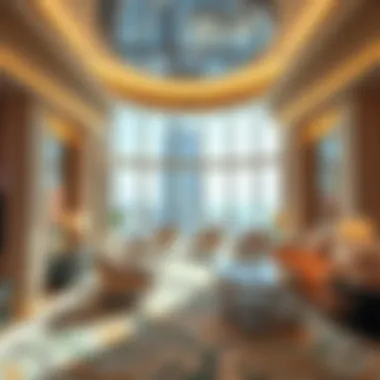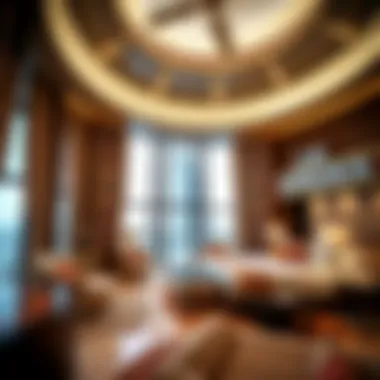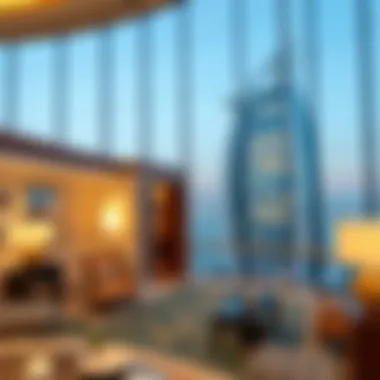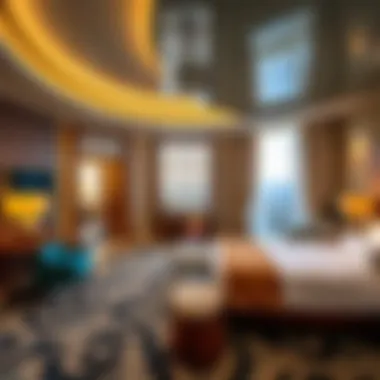Explore the Luxurious Interiors of Burj Al Arab Rooms


Market Insights
Understanding the essence of luxury real estate, particularly in iconic structures like the Burj Al Arab, offers valuable insight into broader property trends. The elegance of its interiors invites not only admiration but also analysis for potential investors and homeowners alike.
With property enthusiasts keeping an eye on the Dubai market, it becomes vital to observe how trends shift in response to global economic climates. Recently, the focus has moved towards sustainability while still maintaining opulence. Developers and investors should take note of this as they shape their strategies around future high-end projects. The Burj Al Arab stands as a testament to timeless luxury; however, the market is trending toward integrating smart technologies and eco-friendly designs into high-end offerings.
Current Property Trends
- Luxury Redefined: Buyers are increasingly seeking homes that deliver not just comfort, but a unique experience. Unique features such as immersive art installations, personalized service options, and design elements that speak of cultural heritage are becoming key selling points.
- Technological Integration: Smart home features are no longer a novelty but a necessity. Potential buyers look for seamless integration of technology that enhances everyday living while offering convenience and security.
- Sustainability: The idea of luxury living is evolving. Properties that incorporate environmentally responsible materials and energy-efficient systems are gaining traction. This aligns well with the luxury brand image that the Burj Al Arab embodies, offering an opportunity for investors to engage with new models of luxury.
Investment Opportunities
Investing in properties of this caliber, including those that draw inspiration from the Burj Al Arab’s design principles, can be a lucrative venture. It’s essential to note:
- The potential for high rental yields, especially in areas with limited luxury inventory.
- A growing market for bespoke experiences, which can enhance property value.
- The opportunity to collaborate with seasoned architects and designers to create distinctive properties that resonate with affluent clients.
Investing in luxury real estate requires a keen understanding of market dynamics. Properties must not only be attractive; they should also promise a lifestyle that draws higher-end clientele.
Practical Tips
For those interested in entering the realm of luxury real estate, whether as buyers or investors, keeping a finger on the pulse of trends is critical. Here’s a concise guide:
Guide to Buying Property
- Research the Market: Stay informed about the latest developments in high-end properties.
- Seek Expert Guidance: Work with experienced real estate agents familiar with luxury offerings. Their insights can prove invaluable.
- Consider Location: The Burj Al Arab's location by the sea speaks to the significance of positioning in real estate. Locations with similar potential will see heightened demand.
Renting vs. Buying: What You Need to Know
- Assess Financial Commitment: Buying often requires a substantial upfront investment, while renting can offer flexibility with lower initial costs.
- Long-term vs. Short-term Gains: Rental investments might provide steady cash flow, while purchasing holds the potential for equity over time.
- Lifestyle Considerations: Depending on personal circumstances, renting might suit lifestyle changes better, whereas buying can lead to long-term stability.
In summary, luxury real estate like the Burj Al Arab exemplifies how aesthetics, functionality, and investment potential align. Understanding the nuances of this sector helps in making informed decisions for a successful venture into the world of upscale properties.
Prologue to Burj Al Arab
Nestled in the heart of Dubai, the Burj Al Arab stands as a symbol of opulence and luxury that captures the world’s attention. As the fourth tallest hotel in the world, it is more than just a place for accommodation—it's a visual marvel, a haven of extravagance, and a significant landmark that reflects the ambitious spirit of Dubai. Understanding the essence of this iconic structure goes beyond merely admiring its exterior; it’s essential to delve into the interiors that define its luxurious experience.
In this article, we will explore each nook and cranny of the Burj Al Arab's rooms. From the exquisite detailing that brings the rooms to life to the innovative technologies integrated into these lavish spaces, readers will gain insights crucial for anyone interested in high-end real estate or hospitality trends.
What makes the Burj Al Arab a cornerstone of luxury?
- The blend of traditional and modern design reflects Dubai’s cultural narrative.
- Each room type offers unique features that cater to different tastes and preferences, setting new benchmarks for hospitality.
- The hotel’s emphasis on personalized service elevates the guest experience, inviting a deeper appreciation for luxury living.
The interior of the Burj Al Arab is steeped in a rich tapestry of textures, colors, and artistic expression, rising above conventional definitions of what a hotel can be. By examining these interiors, we aim to highlight not only the aesthetic choices but also the thoughtful design philosophy stacked behind every decision. It’s an exploration not just of words, but of experiences that resonate deeply with investors, developers, and anyone seeking a glimpse of luxury in the hospitality realm.
As we set this stage, the allure of the Burj Al Arab invites us to step in and savor an experience that captures much more than just a room; it’s about crafting unforgettable moments amidst architectural brilliance.
Luxury isn’t merely a state of mind; it’s an experience that begins the moment you step inside the Burj Al Arab.
Historical Context of Burj Al Arab
The Burj Al Arab stands not just as a luxury hotel but as a symbol of Dubai's rapid transformation into a global city. Understanding its historical context is vital, as it reveals how this astonishing structure fits within both the cultural and economic trajectory of the region. Built during a time of significant economic boom, the Burj Al Arab's construction reflects the aspirations of the Emirate to create landmarks that represent innovation, wealth, and hospitality.
Vision and Construction
The vision behind the Burj Al Arab began in the late 1980s when the rulers of Dubai, eager to showcase their city on the world’s stage, aimed to build a hotel that would redefine luxury. This idea was birthed by Sheikh Mohammed bin Rashid Al Maktoum, who envisioned a structure that not only served as accommodation but also represented the ambitious spirit of Dubai. Construction began in 1994, spearheaded by the renowned architect Tom Wright from the firm WS Atkins. The hotel was designed to resemble a billowing sail, situated on its own artificial island.
To say its construction was groundbreaking is an understatement. The entire process utilized pieces of state-of-the-art technology, including a floating platform to rise above the Arabian Gulf's waters. Workers had to confront the challenges of harsh weather and logistical constraints typical to such an ambitious project. To support the loads of the hotel, over 200 concrete piles were driven deep into the seabed, thus ensuring a stable foundation. Unquestionably, this high level of engineering skill and innovation set the tone for future developments within the city.
Architectural Significance


The architectural significance of the Burj Al Arab extends beyond its aesthetic appeal. It is an embodiment of the relationship between nature and human-made structures, marrying the modern lines with traditional themes. The building's height is a defining feature; standing at about 321 meters, it previously held the title of the tallest hotel in the world. This height is not merely for show; it communicates Dubai's ambitions in the hospitality industry and its goals of attracting tourists from every corner of the globe.
Furthermore, the design incorporates various elements that reflect the rich cultural heritage of the UAE. For instance, the curvature of the sail-inspired silhouette has been interpreted as a nod to the region's historical association with maritime trade and fishing. In addition, choice materials used in the hotel’s interior, such as gold, marble, and high-quality textiles, signify a blend of luxury that pays homage to the opulence associated with royalty.
The Burj Al Arab is a testament to what can be achieved when vision meets resources, showcasing the cultural amalgamation of historic influences and modern techniques.
Architectural Design Philosophy
In understanding the Burj Al Arab, one cannot neglect the significance of its architectural design philosophy. This landmark, rising audaciously above the Dubai coastline, showcases more than mere opulence. It embodies a delicate balance of form and function, blending traditional elements with cutting-edge modernity. The very essence of the hotel reveals cultural narratives and reflects a progressive vision that anchors Dubai's identity as a global destination.
The architectural philosophy behind the Burj Al Arab not only defines its exterior silhouette but also influences the interiors, inviting guests to experience spaces that are both emotionally and physically resonant. It raises questions about how design shapes luxury and hospitality, informing both investors and real estate developers about trends in high-end accommodation.
Symbolism in Design
The design of the Burj Al Arab is a textbook example of symbolism in architecture. Its sail-like structure evokes maritime traditions and local heritage while signaling Dubai’s ambition. Each element within the building’s design serves a purpose beyond visual appeal. For instance:
- Sail Shape: This not only represents the region's seafaring history but serves as an emblem of progress and innovation.
- Height: At 321 meters, it isn’t just about being the tallest; it's about standing as a beacon of luxury and hospitality.
- Color Palette: Rich gold and soothing blue hues mimic the sea and sand, grounding the structure in its environment.
"Architecture is a visual art, and the buildings speak for themselves."
— Julia Morgan
The interiors are no exception, reflecting grandeur through intricate designs that reference Islamic art, a nod to Dubai's rich cultural history. From the lavishly adorned atrium to the carefully crafted in-room furnishings, symbolic motifs abound, reinforcing the idea that luxury here is entwined with cultural identity.
Use of Natural Elements
In a city that’s home to sprawling deserts and endless skyline, the Balancing act of incorporating natural elements into the Burj Al Arab’s design is crucial. The hotel showcases how modern architecture can still respect the surrounding environment and cultural aspects. Here are a few noteworthy elements:
- Water Features: The use of water not only creates a refreshing atmosphere but symbolizes life and abundance, crucial themes in Emirati culture.
- Natural Light: The clever use of glass allows natural light to permeate spaces, enhancing the ambiance and reducing the need for artificial lighting.
- Plant Life: Ingeniously integrated greenery within the atrium reflecting the fusion of natural and man-made beauty, it creates a serene environment amid urban vibrancy.
The incorporation of these aspects highlights a significant consideration in architectural design philosophy — the need for holistic environments that soothe the senses while indulging in luxury.
The Burj Al Arab serves as a case study for aspiring architects and investors alike, illustrating how thoughtful design can elevate a structure from mere function to an icon of culture and luxury, making it a pivotal landmark in the global hospitality sector.
Overview of Room Types
The Burj Al Arab stands not just as a luxury hotel but as a symbol of opulence in the bustling city of Dubai. Understanding the diverse room types available within its towering structure is fundamental for guests considering a stay and for investors looking at the hospitality landscape. Each room type offers a distinct experience, catering to different preferences and budgets while simultaneously maintaining the high standards of luxury that define the hotel.
Exploring the room types allows one to appreciate the careful thought behind their design and functionality. Each room is a microcosm of luxury, showcasing unique features such as bespoke furnishings, stunning views, and cutting-edge technology. These experiences are not just places to sleep but realms of comfort and indulgence. Visitors can expect tailor-made experiences, from personalized services to thoughtfully curated decor that speaks of Dubai's rich heritage combined with modern sophistication.
Royal Suite Features
The Royal Suite in Burj Al Arab represents the pinnacle of luxury. Spanning over 8,400 square feet, it’s an expansive sanctuary that promises privacy and unparalleled sophistication. Decorated in lavish hues of gold and cream, the suite includes a grand living room, a study, and not one but two magnificent bedrooms.
Among many striking features, the suite boasts:
- Private elevator access to ensure utmost discretion.
- A jacuzzi with sea views, allowing guests to soak in the beauty of the Arabian Gulf.
- An elegant dining area that can seat up to 12 guests, perfect for private gatherings.
With its exceptional design, each corner of the Royal Suite exudes a feeling of unparalleled extravagance. It's not merely about staying but rather about experiencing a lifestyle that only a select few can afford.
Presidential Suite Highlights
The Presidential Suite is a class act designed to dazzle. This suite features approximately 3,400 square feet of stylistic sophistication that balances comfort with elegance. Guests will be enamored with the floor-to-ceiling windows, providing panoramic views of the skyline and coastline, adding an enchanting backdrop to any stay.
Key aspects include:
- A luxuriously appointed master bedroom with an en-suite bathroom featuring marble finishes and a deep soaking tub.
- A his-and-hers walk-in closet, making packing and unpacking a breeze.
- State-of-the-art entertainment systems that enhance relaxation after a day of exploration.
Ultimately, the Presidential Suite offers a home away from home, brimming with amenities designed to pamper the elite.
Deluxe Rooms Explained


The Deluxe Rooms of the Burj Al Arab present an inviting space without compromising on the luxury that guests expect. Typically around 1,800 square feet, these rooms infuse comfort with style, making them ideal for those who desire a taste of opulence without the extravagance of the higher-tier suites.
Features that enhance the Deluxe experience comprise:
- Custom-designed beds draped in fine linens, ensuring a restful night.
- A separate seating area that allows for cozy evenings in or work sessions with stunning views.
- A marble bathroom equipped with modern fixtures, providing both elegance and practicality.
Deluxe Rooms are more than just accommodations. They invite guests into an aesthetic realm that celebrates both traditional Arabian flair and contemporary chic, making each stay memorable.
Detailed Exploration of Room Interiors
Understanding the room interiors of Burj Al Arab is vital for anyone considering a stay there or simply wanting to appreciate the architectural finesse of this landmark. Each room is designed not just for comfort but to imbue a sense of opulence that resonates with the hotel’s image as the epitome of luxury. This section dives into the specific materials, artistic elements, and technological integrations that are pivotal to the Burj Al Arab’s unique aesthetic.
Luxurious Materials Used
Marble
Marble plays a central role in the thematic representation of elegance within Burj Al Arab’s rooms. The choice of marble is significant—often showcasing intricate patterns, this stone adds a timeless touch. One of its key characteristics is durability. Known for its robustness, marble flooring and tabletops withstand heavy use while maintaining their aesthetic appeal. The unique veining patterns of different marble types offer every room a distinct personality. However, it requires careful maintenance to avoid stains; thus, it's not just a simple choice but a commitment to ongoing care.
Silk
Silk is another material that contributes greatly to the interior’s lavish feel. Employed in draperies and upholstery, the smooth texture of silk adds not only to the visual splendor but also to the tactile experience of guests. This material brings brightness to the spaces, its sheen reflecting light in enchanting ways. A downside to silk, however, is its propensity to fade with excessive sunlight exposure, necessitating thoughtful management of natural light.
Gold Accents
Gold accents serve as the crowning feature in the decoration of these rooms, symbolizing wealth and allure. Sought after for its striking visual appeal, gold detailing is often found in frames, light fixtures, and decorative pieces. Such glimmers of gold initiate an atmosphere of grandeur while inviting curiosity about the craftsmanship behind them. Nonetheless, overuse can sometimes risk tipping into opulence that feels gaudy, so balance is essential in design.
Artistic Elements and Decor
Local Artisanship
Local artisanship is a cornerstone of Burj Al Arab’s interiors, infusing the rooms with a sense of cultural identity. Each piece, whether furniture or artwork, reflects the rich traditions and craftsmanship of the region, connecting visitors to Dubai’s heritage. The meticulous attention to detail in handcrafted items, such as inlaid woodwork and decorative tiles, showcases the skill of local artisans. This not only enhances the aesthetic appeal but supports the local economy. However, sourcing traditional pieces can sometimes take longer than anticipated, which can be an obstacle for rapid design changes.
Contemporary Art Installations
Contemporary art installations create a dialogue between the past and the future within the hotel’s environment. They provide visual stimulation and elevate the interior design through thought-provoking elements. The unique feature of these installations is their ability to adapt and change, keeping the décor feeling fresh and engaging for repeat guests. While the integration of contemporary art can invite critique concerning taste, it undeniably fosters a culturally rich atmosphere, sparking conversations among visitors.
Smart Room Technology
Automated Lighting
Automated lighting systems are an essential part of the room experience. They not only allow guests to adjust their ambience at a touch but also enhance energy efficiency, an increasingly relevant consideration. The ability to control light levels seamlessly adjusts the mood, whether a guest seeks bright illumination for work or soft lighting for relaxation. However, technological glitches can sometimes lead to frustrations if systems fail.
Advanced Entertainment Systems
Advanced entertainment systems in the rooms represent the intersection between luxury and technology, offering a suite of options—from high-definition screens to integrated sound systems. This technology provides guests with a home-like entertainment experience, which is vital for modern travelers. However, heavy reliance on tech can sometimes detract from the overall serenity, as not all guests may appreciate the constant presence of technology in relaxation spaces.
Understanding these elements provides deep insights into why the Burj Al Arab is not merely a hotel but a beacon of modern luxury, emphasizing sophistication through design.
Amenities and Services
The Burj Al Arab is not just a visual marvel; it’s a veritable tapestry of luxury where every room boasts opulent comforts and advanced facilities. Amenities and services play an integral role in defining a guest's experience, ensuring their stay goes beyond mere accommodation. This section dives into two critical facets of the hotel’s offerings: personalized services, such as private butlers and concierge services, and recreational facilities, including spa and wellness options and diverse dining choices. Each of these elements enhances the overall experience, making the Burj Al Arab a significant landmark in Dubai's hospitality landscape.
Personalized Services
Private Butlers
When thinking of ultimate luxury, the notion of private butlers often surfaces. In the context of the Burj Al Arab, having a dedicated private butler transforms a standard hotel stay into a tailored experience. Each butler is trained to pay meticulous attention to detail, ensuring nothing is amiss throughout a guest's visit. One top characteristic that stands out is the level of discretion they maintain. From drawing a bath infused with essential oils to providing personalized shopping experiences, these professionals tend to every whim.
An often-overlooked feature of private butler service is their proactive approach. Instead of waiting for requests, butlers anticipate needs, which proves invaluable, especially for those on tight schedules or seeking spontaneity. Some disadvantages might include a potential reliance on this service; guests may find it hard to adapt to traditional hotel experiences after enjoying such luxuries.


Concierge Services
Concierge services at the Burj Al Arab are another cornerstone of its hospitality. These skilled professionals serve as gateways to unique experiences. Whether a guest wishes to book a surprise desert safari or arrange for helicopter tours over the Palm Jumeirah, concierge teams can make it happen seamlessly.
The primary characteristic of concierge services at the hotel is their extensive local knowledge. Each member offers insights into Dubai that are not easily accessible through standard travel websites. For instance, they can recommend hidden gems for dining or lesser-known attractions, offering a more enriching visit. However, one should note that, during peak seasons, availability may be limited, which can hinder spontaneous plans.
Recreational Facilities
Spa and Wellness
In a world where stress can take a toll, the spa and wellness facilities at the Burj Al Arab stand out. This oasis is designed to rejuvenate both body and mind. With treatments ranging from traditional massages to contemporary wellness therapies, there’s something for everyone. The spa emphasizes personalized treatments based on individual guest preferences.
One of the unique features of the spa facility is its focus on natural ingredients, incorporating local elements like Arabian oils and herbs in various treatments. This approach not only promotes relaxation but also connects guests to Emirati culture. While the various offerings are generally well-received, the cost of treatments can be a consideration, especially for those on a budget.
Dining Options
Dining at the Burj Al Arab is an experience in itself, with options that cater to every palate. From casual cafes to gourmet restaurants patronized by world-class chefs, the food scene is extensive and varied. The emphasis on quality and presentation is paramount; each meal feels like a masterpiece on a plate.
One notable feature is the hotel's dedication to providing authentic local cuisine while integrating international flavors. This fusion approach attracts both tourists and locals, making it a culinary hotspot. However, advanced reservations are often necessary, particularly for the more sought-after eateries, which might restrict spontaneity for some guests.
Ultimately, amenities and services at the Burj Al Arab are not mere add-ons; they are fundamental to the overall narrative of luxury and comfort that the hotel embodies.
Cultural Significance of Burj Al Arab Rooms
The interior spaces of Burj Al Arab are not just places for guests to rest their heads; they embody a rich tapestry of cultural significance that resonates beyond mere luxury. The design, materials, and artistic elements found within these rooms serve as a bridge between the traditional values of Dubai and the contemporary pace of modernity. This section examines how this fusion influences the broader hospitality landscape and contributes to Dubai's identity.
Fusion of Traditional and Modern
In the hustle and bustle of Dubai, Burj Al Arab stands out as an architectural wonder that pays homage to both its rich heritage and forward-thinking ethos. The rooms reflect this unique blend beautifully. For example, the incorporation of traditional Arabic design elements such as intricate mashrabiya screens creates a sense of local authenticity. These screens allow for privacy while letting in natural light, enhancing the overall ambiance.
On the other hand, modern touches are evident in the use of cutting-edge technologies and contemporary furnishings. For instance, guests can enjoy automated climate controls and a wide array of entertainment options. This combination of styles not only appeals to visitors but also attracts investors looking for innovations in the high-end hotel sector.
"The rooms of Burj Al Arab signify a dialogue between two worlds: one steeped in tradition and the other racing toward the future."
Furthermore, the artwork displayed throughout the hotel, often created by local artists, adds layers of cultural depth. These pieces spark conversations among guests, fostering appreciation for Emirati artistry. Such thoughtful curation underscores the commitment of Burj Al Arab to celebrate local culture while offering an international experience.
Impact on Dubai's Hospitality Sector
The cultural significance of Burj Al Arab's rooms extends well into Dubai's hospitality sector. As one of the most recognizable landmarks in the Emirates, it sets a high bar for luxury accommodations. Other hotels often look to Burj Al Arab for inspiration, vying to create similarly immersive experiences that resonate with both tourists and business travelers alike.
Moreover, Burj Al Arab's focus on opulent, culturally enriched interiors has encouraged a wave of development in the region. As cities around the world shift toward more luxurious, experience-driven stays, it's crucial to understand how Burj Al Arab has paved the path for this evolution.
Consider the following impacts:
- Benchmark for Luxury: Burj Al Arab continues to define what a luxury hotel experience should entail, with the expertise of architects, designers, and hoteliers learning from it.
- Cultural Exposition: The hotel acts as a platform for showcasing Emirati culture, thus attracting those keen to engage with local heritage.
- Innovative Designs: The integration of technology in various room designs inspires hotel developers across the globe to think creatively about comfort and functionality.
In summary, the rooms of Burj Al Arab serve not only as lavish spaces that exude elegance but also as pivotal players in the evolving narrative of Dubai's tourism and hospitality sectors. They remind both investors and visitors alike of the intricate relationship between culture, design, and hospitality.
Closure
The exploration of the Burj Al Arab's interiors is not merely an academic exercise; it holds numerous implications for various audiences—particularly investors, homeowners, real estate agents, tenants, and developers. This iconic hotel, with its unparalleled luxury and innovative design, serves as a case study on how architecture can define and elevate a space.
Understanding the unique features and amenities of each room type allows potential investors to recognize the value inherent in such properties. For instance, the customizable experiences offered to guests stem from an intricate understanding of customer needs and preferences, making it a prime example of successful hospitality management. This article has dissected the opulence found within Burj Al Arab's rooms—from the Royal Suite adorned with lavish materials to the advanced technological integrations that enhance guest comfort.
Furthermore, the fusion of traditional and contemporary design elements in the hotel's decor not only enriches the luxurious experience but also reflects cultural significance and heritage. By marrying these influences, the Burj Al Arab reinforces Dubai's position as a global leader in luxury tourism.
As Dubai's real estate landscape continually evolves, the insights gathered from this comprehensive examination of the Burj Al Arab can guide future development projects. The blending of luxury, technology, and cultural elements in hotel design is likely to become increasingly important in attracting discerning clientele.
In summary, the Burj Al Arab stands as a beacon in the hospitality sector, showcasing how thoughtful interior design can shape experiences, enhance brand value, and contribute to the overall image of a destination. For those engaging with this vibrant market—be it through investment or professional practice—understanding such landmark properties adds a valuable layer to strategic decision-making.
"Luxury is not a privilege of the rich, but rather an experience that transcends wealth."
For further reading on this topic, you might find these resources worthy:
- Burj Al Arab - Wikipedia
- The Architectural Wonders of Dubai - Britannica
- Dubai's Hospitality Landscape Discussion - Reddit
- Urban Development and Cultural Heritage - *.gov/.edu















